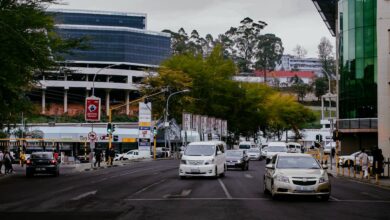Amazon to Resume Drone Delivery Following Crash in Arizona

Amazon to Resume Drone Delivery Following Crash in Arizona
Estimated Reading Time: 7 minutes
- Amazon’s Prime Air drone delivery is resuming operations despite a recent crash in Arizona, signaling the company’s strong commitment to its futuristic logistics vision.
- The incident prompted a temporary halt and thorough investigations by regulatory bodies, leading to crucial safety enhancements and operational adjustments.
- Drone delivery is vital for Amazon’s future, offering unparalleled speed, operational efficiencies, and access to remote locations, differentiating it in the e-commerce market.
- Navigating regulatory landscapes and fostering positive public perception through transparent communication and robust safety protocols are critical for widespread adoption.
- The continuous learning from challenges, combined with collaborative efforts from consumers, businesses, and regulators, will pave the way for successful integration of autonomous aerial systems.
- The Crash and the Pause: A Closer Look at Safety Measures
- Why Drone Delivery is Crucial for Amazon’s Future
- Navigating the Regulatory Landscape and Public Perception
- A Glimpse at Real-World Drone Delivery Today
- Actionable Steps for the Future of Drone Delivery
- Conclusion: The Flight Path Ahead
- Frequently Asked Questions (FAQ)
The skies above our cities and towns are slowly but surely transforming into a new frontier for delivery services. At the forefront of this revolution stands Amazon, a company synonymous with pushing the boundaries of e-commerce and logistics. Its ambitious Prime Air drone delivery program, designed to bring packages to customers in under an hour, represents a significant leap towards futuristic shopping experiences. However, innovation rarely comes without its hurdles.
Recently, Amazon’s progress faced a setback with a drone crash in Arizona, prompting a temporary pause in its localized delivery operations. This incident brought to light the inherent complexities and risks associated with pioneering autonomous aerial systems. Yet, in a testament to its unwavering commitment to this vision, Amazon is now preparing to resume its drone delivery services, underscoring its belief in the long-term viability and safety of this technology.
This decision not only reflects Amazon’s resilience but also highlights the critical importance of continuous innovation in the evolving landscape of last-mile logistics. As the world moves towards faster, more efficient, and sustainable delivery solutions, the lessons learned from such incidents are invaluable, shaping the future of how goods reach our doorsteps.
The Crash and the Pause: A Closer Look at Safety Measures
The incident in Arizona served as a stark reminder that even the most advanced technological systems can encounter unexpected challenges. While details surrounding the specific cause of the crash remain under wraps, Amazon’s immediate response was to halt operations, prioritizing safety and a thorough understanding of what transpired. This proactive pause is crucial in any nascent technology sector, allowing for comprehensive review and necessary adjustments.
Such events inevitably draw scrutiny from regulatory bodies tasked with ensuring public safety and the orderly conduct of air operations. It is important to note that Investigations by the National Transportation Safety Board and Federal Aviation Administration are underway. These investigations are not merely punitive; they are instrumental in gathering data, identifying potential vulnerabilities, and ultimately, informing improved design, operational protocols, and regulatory frameworks for all unmanned aerial systems (UAS) operating in public airspace.
For Amazon, the resumption of services indicates that internal assessments, combined with initial findings or corrective actions, have provided sufficient confidence to proceed. This often involves rigorous software updates, hardware modifications, enhanced pre-flight checks, and perhaps even adjustments to flight paths or operational zones. The path to fully autonomous, widespread drone delivery is paved with continuous learning and adaptation, with safety as the paramount concern.
Why Drone Delivery is Crucial for Amazon’s Future
Beyond the immediate challenges, the strategic importance of drone delivery for Amazon’s long-term vision is undeniable. The e-commerce giant is constantly seeking ways to optimize its supply chain and enhance customer satisfaction, and Prime Air stands as a cornerstone of this strategy.
Firstly, drones offer unparalleled speed in last-mile logistics. Imagine ordering a forgotten ingredient or an urgent item and having it arrive within minutes, not hours or days. This “instant gratification” model sets a new standard for customer convenience, differentiating Amazon in a competitive market.
Secondly, drone delivery promises significant operational efficiencies. By bypassing road traffic and reducing reliance on traditional delivery vehicles, drones can lower fuel costs, decrease delivery times, and potentially alleviate congestion in urban areas. This translates to a more sustainable and cost-effective delivery network in the long run, particularly for lighter, smaller packages.
Furthermore, this technology opens up new possibilities for reaching remote or difficult-to-access locations where traditional ground transportation is inefficient or impractical. It also positions Amazon at the forefront of automation, enabling a scalable delivery infrastructure that can adapt to fluctuating demand and further reduce human error in the delivery chain. These cumulative benefits are why Amazon remains steadfast in its pursuit of aerial delivery, viewing it as an indispensable component of future commerce.
Navigating the Regulatory Landscape and Public Perception
The journey towards widespread drone delivery is not just a technological race; it’s also a complex dance with regulatory bodies and public opinion. Integrating thousands, or even millions, of autonomous vehicles into shared airspace requires robust, adaptive, and scalable regulatory frameworks. Authorities like the FAA are tasked with establishing rules for flight paths, altitude restrictions, operator certifications, and privacy considerations, all while ensuring national security and preventing air traffic conflicts.
Public perception plays an equally vital role. Incidents like the Arizona crash, though isolated, can erode public trust and fuel concerns about safety, noise pollution, and privacy. Amazon and other drone operators must actively engage with communities, demonstrating the benefits of drone delivery while addressing fears through transparent communication, rigorous safety protocols, and effective mitigation strategies.
Building public acceptance means not just proving the technology is safe, but also showing that it is a positive addition to society. This includes illustrating environmental benefits (e.g., lower emissions compared to gasoline vehicles) and economic advantages for local communities. The collaboration between innovators, regulators, and the public will ultimately determine the pace and scale of drone delivery adoption.
A Glimpse at Real-World Drone Delivery Today
While Amazon works towards broader deployment, drone delivery is already making strides in niche applications. For instance, Alphabet’s Wing has been operating commercial drone delivery services in suburban areas of Australia, Finland, and parts of the U.S. for years, delivering everything from coffee to household essentials. Similarly, Zipline utilizes fixed-wing drones to deliver medical supplies, including blood and vaccines, to remote clinics in Rwanda and Ghana, proving the life-saving potential and logistical efficiency of autonomous aerial systems in challenging environments. These examples underscore the current capabilities and the vast future potential of this technology.
Actionable Steps for the Future of Drone Delivery
As Amazon and others continue to push the boundaries of autonomous delivery, stakeholders across the board have a role to play in shaping its successful integration.
- For Consumers: Stay Informed and Provide Feedback. Understand local drone delivery initiatives and participate in community discussions. Your input on noise, convenience, and perceived safety is invaluable for companies and regulators to refine services. Consider opting-in for trial programs if available in your area to experience the technology firsthand.
- For Businesses (Considering Autonomous Logistics): Prioritize Safety and Redundancy. Learn from pioneers like Amazon. Implement rigorous testing, invest in redundant systems (both hardware and software), and establish clear, comprehensive emergency protocols. Ensure your operational safety case is robust and continuously updated based on real-world data and regulatory guidance.
- For Regulators and Policymakers: Develop Adaptive and Collaborative Frameworks. The pace of technological change demands agile regulation. Foster international cooperation to standardize rules where possible, and create pathways for innovators to test and deploy new technologies safely. Balance innovation with public safety, ensuring regulatory frameworks are clear, enforceable, and scalable for future growth.
Conclusion: The Flight Path Ahead
Amazon’s decision to resume drone delivery following a crash in Arizona is more than just a corporate announcement; it’s a clear signal of the company’s long-term commitment to revolutionizing last-mile logistics. While the incident served as a potent reminder of the challenges inherent in pioneering advanced technologies, it also provided invaluable lessons that will undoubtedly lead to safer, more robust systems.
The vision of autonomous drones efficiently whisking packages to our doorsteps is not merely a futuristic fantasy but an imminent reality. Through continuous innovation, a steadfast focus on safety, and collaborative efforts with regulatory bodies and the public, Amazon aims to overcome the hurdles. The path ahead requires patience, persistent refinement, and a shared understanding that while occasional setbacks are inevitable, the transformative potential of drone delivery for convenience, efficiency, and sustainability is too significant to ignore.
As Prime Air takes to the skies once more, it represents a bold step towards a future where technology seamlessly integrates into our daily lives, making once-unimaginable services a commonplace convenience.
Ready for the Future? Sign Up for Amazon Prime Air Updates!
Frequently Asked Questions (FAQ)
Here are some common questions about Amazon’s drone delivery program and the future of autonomous logistics:
What is Amazon Prime Air?
Amazon Prime Air is an ambitious drone delivery service aimed at delivering packages to customers safely in 30 minutes or less. It represents Amazon’s commitment to innovating last-mile logistics and enhancing customer convenience.
Why did Amazon pause drone delivery operations?
Amazon temporarily paused its drone delivery operations following a crash in Arizona. This pause allowed for thorough internal assessments, investigations by regulatory bodies like the NTSB and FAA, and the implementation of necessary safety improvements and operational adjustments.
What are the key benefits of drone delivery for consumers and businesses?
Drone delivery offers several benefits, including unparalleled speed for last-mile logistics, significant operational efficiencies (lower fuel costs, reduced traffic congestion), potential for reaching remote locations, and a more sustainable delivery network due to reduced reliance on traditional vehicles.
How are regulators involved in drone delivery?
Regulatory bodies, such as the FAA, are crucial for establishing frameworks that ensure public safety and orderly air operations. They set rules for flight paths, altitude, operator certifications, and privacy, working collaboratively with innovators to integrate autonomous aerial systems safely into shared airspace.
What are the challenges to widespread drone delivery?
Challenges include developing robust and adaptive regulatory frameworks, overcoming public perception concerns regarding safety, noise, and privacy, ensuring technological reliability, and scaling operations while maintaining stringent safety standards.





